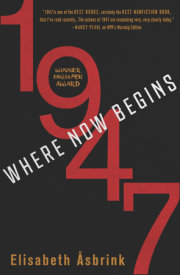JANUARY ’Arab al-Zubayd Hamdeh Jom’a is a strong-willed girl, but somewhere there is a limit. And it is getting closer.
When the man with the magic box comes to the village, he calls the children together. The little ones are to ask their mothers for grain, the older ones are to pilfer food, but everyone has to come to see the magic box, which — so the man claims — eats sugar and shits sweets. They laugh and pay him in bulgur wheat, lentils, and oats. He tells his tales and shows his pictures, which turn into stories when he puts a stick into the cardboard box and stirs.
Hamdeh is sixteen and can’t get enough of the moving pictures’ magic. She filches bread from her mother to pay the man, takes handfuls of lentils from the stores. She thinks of her uncle, who owns a great many hens and five cockerels. During his afternoon nap, she sneaks in and steals some eggs — just so she can see the pictures moving again, hear about heroes and freedom fighters, feel the world expand. But as she leaves her uncle’s tent with the eggs, he awakes, catches the girl, and strikes her. The eggs are smashed, and that night Hamdeh, her apron soiled, sleeps in a cave to avoid his anger. But that blows over.
Every evening, when he has told his stories to an end, the man with the magic box concludes with the same words: “This is the darkness, this is the night.”
Washington In the Oval Office at the White House, President Truman sits writing his diary. He wakes early on January 6 and fits in a few hours’ work before strolling down to the station to meet his family. A good 35-minute walk, he notes, glad to have his wife and daughter back home. The great white jail is a hellish place to be alone. The floors creak and crack at night. It takes little imagination for him to picture old James Buchanan wandering back and forth, full of anxiety over a world beyond his control. In fact, the unquiet spirits of many presidents traipse up and down the stairs, complaining about what they should have done better and what they failed to achieve. Some of his late predecessors are absent, Truman writes in the blue diary. They simply don’t have the time, being far too busy controlling heaven and governing hell. But the others, the poor, tormented presidents who were misrepresented in history, get no rest. The White House is a hellish place.
London It is announced on January 7 that 500 women employed by London Transport have to vacate their posts. They’re being sent home. In the months to come, all London’s bus and tram conductresses will be dismissed — 10,000 of them altogether. The men are back.
Malmö Movements at the border, trees like black lines in a white landscape; footsteps on frozen ground leave few traces. The world is full of fugitives eager to escape. Some borders are less tightly controlled than others, the roads narrow and winding, the locals occupied with their own affairs.
A border between Germany and Denmark; another between Denmark and Sweden; maritime boundaries; land borders; lines drawn on paper maps, but in reality marked by a stone, a fence, a thousand dry stalks of grass rustling in the passing wind.
Many are fleeing from their experiences, others from the consequences of their acts. Silence. Secrecy. Coded messages, and never more than one night in the same place. Men stream out of Germany into Denmark and continue their journey toward Sweden. Helping hands provide them with food and a bed for the night along the way.
Per Engdahl wants his passport back. Denied it, he finds himself confined to his own country, which he wants both to preserve and to expand until the borders give way. This is a contradictory vision which he will work tirelessly to realize. The Swedish Security Service classes him as a Nazi, and after a visit to Vidkun Quisling in wartime Norway, and a subsequent journey to Finland on which he met some of the Wehrmacht’s top brass, his passport has been confiscated. Although Engdahl makes several attempts to recover it, this takes a while — so he has others come to him, to Malmö. He has loyal collaborators who travel and organize things on his behalf. Barely any documents remain, and only a few names are mentioned in the papers that survive him.
Only through detours, unraveling threads of facts, seeking out and piecing together the events of the months that form 1947, can information be found about a time when everything seemed possible, as it had already happened.
They come from all corners of Europe. Most have fought in SS divisions on the Eastern Front, and many Balts are at risk of extradition to the Soviet Union. All of them need help to evade the consequences of their wartime actions, and the man without a passport welcomes them.
Though Per Engdahl is the leader of Sweden’s Fascists, he wants to keep the white flow of fugitives seeking his aid outside the movement, discreetly concealed and coded. Thus his own home — 2, Mäster Henriksgatan, Malmö — becomes the center of operations. The fugitives’ reception takes on a literary character; the Fascist, who also writes poetry, uses book titles as code words for “refugee,” “hiding place,” and “movement” — all to keep the Swedish police unaware.
How many come? No one is sure. Who are they? No one knows. However, among the thousands of men on the run, one or two become more than just a name — maybe even a friend. One such is Professor Johann von Leers, the right-hand man and protégé of Propaganda Minister Goebbels, and one of the most influential ideologues behind the Nazis’ hate propaganda. An iron-willed, committed Jew-hater, belonging to the Nazi leadership. Von Leers was captured by US troops and interned in Darmstadt, but fled after 18 months. After that, he left only diffuse and contradictory traces. He managed to disappear altogether for several years, making a definite reappearance in 1950, in Buenos Aires. Some claim he went underground in northern Germany for several years; others say he lived incognito in Italy.
What we do know is that in late 1946 he travels to the old merchant city of Flensburg, not far from the Danish border. He is met there by a Danish SS volunteer, Vagner Kristensen, who guides him to Padborg in Denmark, a distance of just over six miles.
“We took the refugees along a path, across a marsh, and over the border.”
The young Kristensen takes a liking to Johann von Leers
— they will stay in touch — and escorts his new friend further across Denmark to Copenhagen, where others take over, arranging a boat over the Öresund strait.
“They were obliged to come to me when I couldn’t travel,” Engdahl would later reminisce with a certain pride, though he carefully avoided letting slip a single name.
Engdahl and his friends manage to find jobs for a thousand or so Nazi fugitives. Kockums shipbuilders and Addo, the calculator manufacturer, are happy to take them on, provided that Engdahl avoids mentioning it in his magazine,
Vägen Framåt. All of them know the score: action is fine, but in obscurity, away from the light.
Per Engdahl: poet, journalist, Fascist leader. The Swedish police regard him as the real founder of Swedish Nazism.
“Even before the war he was known as the Swedish Nazi with the best connections in international Nazism. He was
persona grata in Berlin and Rome … By the end of 1945, Engdahl had already contacted the remaining Nazi and Fascist cells outside Sweden,” writes the central police authority, the State Police, in a summary from the early 1950s.
Rome Just a few days before 1946 gives way to 1947, five men gather on the Viale Regina Elena in Rome: a journalist, an archaeologist, an auditor, a trade-union leader, and a man claiming to be Benito Mussolini’s illegitimate son. Together, they found the Movimento Sociale Italiano, a movement based on the same ideas and ideals as Mussolini’s Fascist Party had. MSI rapidly attracts numerous supporters, and large amounts of money through private donations. Only a month or so later, local sections are set up all over Italy, and the movement can begin its work of attacking democracy and countering Communism. But not just in Italy. The movement’s goals include a new Europe. Falangists in Spain, Peronists in Argentina, British Fascists under Oswald Mosley, neo-Nazis meeting illegally in Wiesbaden under the leadership of Karl-Heinz Priester. And Per Engdahl in Sweden. They lurk under the surface, making their moves when the world is looking elsewhere. Even now, they are setting up among themselves a well-organized system of couriers to circumvent passport, visa, and currency restrictions. Soon the men will come closer together, even merge. The pent-up stillness of a pendulum about to strike back.
Poland On January 19, elections are held in Poland. But over the course of the last few weeks, half-a-million people have been accused of collaboration with the Nazis and disenfranchised by way of punishment. Over 80,000 members and supporters of the anti-Communist party Polskie Stronnictwo Ludowe [Polish People’s Party] are arrested on the eve of the elections. Around a hundred of them are murdered by Poland’s secret police.
As a result, the Communists win a landslide victory.
At the 1945 Yalta Conference, Stalin promised free elections in Poland — but for the multiparty system, today is the moment of death.
Al-Mahmudiyyah The son of an Egyptian clockmaker, Hasan al-Banna, wants to turn time towards Islam. Once he was an eager learner, willful and strong-minded like his mother, and more outgoing than his father. The time of the world was adjusted in his father’s workshop, where silent dials waited for hands, tiny cogwheels lay gleaming in boxes, and the sound of a mended clock was reward enough for the effort of repairing it. The ticking, distinct and regular, showed that both the object and time itself had been restored from disorder to order, from chaos to control. Outside Hasan’s father’s workshop lay Egypt with its wheat fields, the men crouching under the contemptuous gaze of the British: an unfree country. And the verses of the Qur’an were lined up as tightly as the ears of wheat in the fields.
The boy, too, learned his father’s craft. Being in a room full of clocks turns an hour into friend and enemy alike. Taking a clock apart, scrutinizing its inner mechanisms, and then getting time to work again transforms time into a power that can be controlled.
Paris An aircraft carrying Simone de Beauvoir takes off for New York. There are just ten passengers and 40 seats; boarding the plane, she already feels lost. It’s as if she is leaving her life in Paris behind her. Something different, something new, is going to be revealed, and it will make her a different person. The plane is in the air. It is January 25. She writes: “I am nowhere. I am somewhere else. What is time?”
New York Now is a time without universal human rights. But has humankind missed something it didn’t know existed? Have the world’s religions, seeking to shield that which is human as though it were a fragment of the divine, provided adequate protection?
The world rises out of greasy human ashes. Here and now, in the United Nations’ provisional secretariat in the aircraft factory at Lake Success, universal values are to be established: new thoughts, new premises for humankind, a new morality. A person’s rights are not to depend on whether they are Christian or Buddhist, on whether they were born into a family with or without assets, or on their name, sex, position, country of birth, or skin color.
Entering world history, a 60-year-old woman leads the deliberations. She has just lost her driving license for careless driving. Somewhere beneath the stream of day-to-day political happenings and her sadness at the death of her husband, Franklin D. Roosevelt, somewhere beneath the layer of thoughts about aging, motherhood, and the fact that people are unused to a female leader, run the words that will follow the working party from this first day to the last, the same regardless of whether one reads the Confucian philosopher Mencius or the twelfth chapter of Paul’s Letter to the Romans: “Do not be overcome by evil, but overcome evil with good.”
Eleanor Roosevelt convenes her first meeting with the working party on January 27. There is a certain euphoria in the air. Never again, say the world’s people to each other and themselves. Never again, say the members of the working party charged with creating human rights, who hardly grasp the magnitude of their task.
Never again. The words are repeated like the fringes on a prayer shawl, as if god existed.
Malmö A winter wind blows through the streets of Malmö. The temporary visitor Herr von Leers excels in hatred. Once Goebbels’s chief ideologue, he had proved to be an asset when it came to spreading malice.
In his pamphlet
The Jews are Looking at You, published in 1933, he named a number of people who he believed to be Jewish — eminent German politicians, scholars, and artists — published photographs of them, and incited his fellow party members to murder them. One of them was Albert Einstein, who had already left Germany by then. “Not yet hanged,” von Leers noted. But a number of the others he named were abducted and murdered, as though his words had the force of an order.
Now he is visiting Malmö.
Who purchases his ticket, who meets him at the harbor, who takes him to Per Engdahl?
He stays for a while, and the two men spend time together. What can they have discussed, what do they have in common, the Swedish Fascist leader and Goebbels’s most eloquent Jew-hater? Could it be here that dreams are nurtured, that thoughts of a new future are cast in words? Is it now, in these first few days of the year, together with Johann von Leers, that Per Engdahl clarifies his vision of a postwar Europe?
The stream of SS soldiers fleeing via the Nordic countries persists. Per Engdahl sees himself as the nerve center in an organization made up of separate cells which do not know each other but are working together for a common goal: to save the courageous men in danger of punishment and extradition to hostile powers. Engdahl seems to be driven by a strong sympathy for the SS men, especially the Balts who are at risk of being deported to the Soviet Union: “We were there. We knew the score. We saw people without any really safe place anywhere in the world, people who had seen their native countries, who were being hunted like wild beasts …” He writes about the boats from Sweden to Spain or Latin America, but mentions in his autobiography that most SS men were sent to West Germany, regarded as relatively safe. He and his collaborators may have helped some 4,000 men, possibly slightly fewer.
A few years later, Johann von Leers will land in Buenos Aires, which boasts one of the larger colonies of Nazi criminals. President Perón is happy to receive them, not just because he sympathizes with their ideas, but also because he receives generous remuneration for his trouble from Third Reich funds. And Johann von Leers and Per Engdahl will continue to build their dreams, both separately and together.
Copyright © 2017 by Fiona Graham. All rights reserved. No part of this excerpt may be reproduced or reprinted without permission in writing from the publisher.











